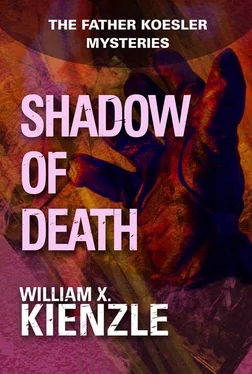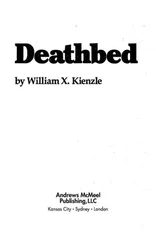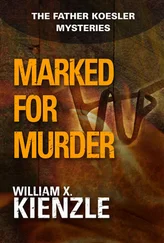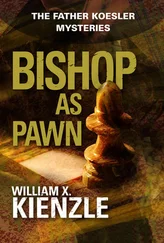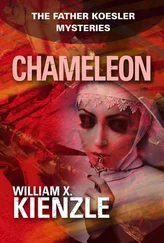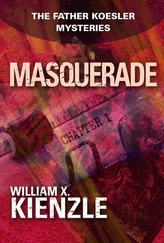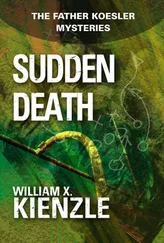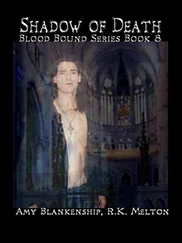“There are two kinds of people who go through a complete primary, secondary, and college Catholic education: those who pay attention, and those who don’t. I belong to the former group.”
They had to hurry. Lost in conversation, Cox and Lennon had fallen behind the group who had exited St. Edward’s Chapel and reentered the main section of the abbey.
“Now, ladies and gents, I’ll just call your attention to the high altar here. Isn’t it a beauty! The high altar and that very ornate wooden screen behind it that runs along the whole wall were designed by Sir Gilbert Scott in 1867. The mosaic just above the altar, as you can well see, represents the Last Supper. It is at the high altar that the truly great services take place. The ecumenical service tonight, in fact, will take place right here. And that large golden cross you see over there on the left is the very processional cross that will be used in tonight’s service.
“And now, ladies and gents, we’ll just go on through the north transept here. And I’ll just point out a few things to you as we continue on out through the north entrance and board our coach for the final leg of our tour.”
As the group began moving out, Toussaint noticed that Koesler had remained behind just outside the sanctuary directly in front of the high altar. He was standing stock-still, looking intently at the floor.
Toussaint crossed to him. “What is it, my friend?”
“Ramon, I know we weren’t supposed to be looking for anything in particular, but I think I found something anyway.”
Toussaint followed Koesler’s gaze to a spot on the floor. There, almost blending in with the Persian carpet, were two images of black fists, side by side.
The two stood motionless for a moment.
“My friend,” said Toussaint, “I believe you have stumbled upon the very spot where the assault is planned to take place. Congratulations.”
“We have to get word of this to Inspector Koznicki!” It was Koesler’s first thought.
“Yes. But we cannot alarm or alert any of the others, especially those two reporters. It will be important that the police alone know about this.” He thought for a moment. “You go now and inform the Inspector about what you have discovered. I will continue on with the group and conclude the tour. If anyone asks about you, I will make some excuse for your absence. Now go, my friend.”
Koesler hurried for the west entrance while Toussaint caught up with the tour group just as it was exiting the abbey.
As Toussaint boarded the bus he seemed lost in thought. Gradually, his thoughts were transformed into prayers; prayers of gratitude for the success they had so far enjoyed in protecting Cardinal Boyle, and prayers of petition for continued success.
4.
“Now, ladies and gents, here we are at our last stop today, the very famous and, if I may say so, infamous, Madame Tussaud’s Wax Museum.
“Be careful now, each of you, to take one of these passes as you leave the coach. With the pass, you won’t be needin’ to buy a ticket at the door.
“Now, ladies and gents, the exhibition takes up four floors of the museum. On the ground floor is the Battle of Trafalgar. On the first floor, you’ll find the Grand Hall containin’ kings and queens as well as the present royal family. On the upper floor will be the tableaux, the conservatory, and some of yer popular heroes. And, ladies and gents, below ground, and appropriately enough, I might add, is the Chamber of Horrors.
“We’ve only an hour, so step lively now. The next time I see you folks I won’t be able to recognize you ‘cause your hair’ll be standin’ on end after goin’ through the Chamber of Horrors.”
An appreciative titter from the group.
To Toussaint, the building resembled an old theater slightly gone to seed. There was no one waiting to enter. This must be a slow time at Madame Tussaud’s, he thought.
As he entered the museum, Toussaint became conscious that, even though he was a member of a tour group, he was quite alone; now that Koesler was no longer with him, he was with no one. The only person with whom he might have conversed was Irene Casey. And she was busy talking with Joan Blackford Hayes. Just as well, he concluded; his mind was busy with what they had just found in Westminster Abbey.
Thus distracted, Toussaint found himself staring at a pale, unblinking head. It was the wax image of Admiral Nelson as he lay dying aboard his ship at the climax of the Battle of Trafalgar. Toussaint read the description posted nearby. It stated that Nelson had signaled the beginning of that mighty sea battle by announcing, “England expects that every man will do his duty.” And as he lay dying, he uttered the immortal words, “Thank God I have done my duty.”
A smile crossed Toussaint’s face as he contrasted the related statement of the late General George Patton: “Don’t be a fool and die for your country. Let the other sonofabitch die for his.”
Time certainly seemed to change the philosophy of war; Toussaint agreed wholeheartedly with Patton.
He climbed one flight and found himself among the kings and queens of history. Henry VIII and his wives! The last one, Catherine Parr—the only one of his wives with any luck at all—had been lucky enough to outlive Henry. Toussaint moved on and found himself passing American presidents, French, Russian, and Chinese leaders. Even a lifesize figure of Pope Leo XIV. Very realistically, the Pope looked tired. So tired he appeared ready to fall down and die.
Toussaint continued to stroll by the exhibits, but his final thought about the Pope triggered musings over the recent assaults against probable papal candidates. What a wild, rash plot! But a plot that had already produced two murders and one attempted murder. And, in all likelihood, another attempt at murder this evening.
Even with all their preparations, the police would have to be on their toes tonight. They simply couldn’t disrupt a public religious service by detaining and interrogating each seemingly suspicious-looking person who entered the abbey. Besides, if they were to be totally and ultimately successful, it would be counterproductive to frighten away the perpetrators or alert them to the fact that they were walking into a trap.
No; tonight’s operation must appear to be an ordinary ecumenical service. And this would immediately put the police at a disadvantage. It takes only a second for an assassin to strike. The police had only a fraction of a second to counterattack.
The police would need a lot of luck this evening.
No, not just luck; God’s providential care.
Without quite being conscious of it, Toussaint had climbed another flight. He was now on the top floor amid the tableaux, the conservatory, and the heroes. Apparently, even with all his distractions, he was making better time than the others. He could, faintly, hear some of their voices from the floor below, but none of them was in sight.
In front of him was a mean-looking little wax man holding a sword and standing near a barrel of what appeared to be a keg of gunpowder. Toussaint checked the descriptive note. His guess was correct: it was Guy Fawkes, one of the leaders of the unsuccessful plot by a group of Catholics to blow up the Houses of Parliament.
How history might have been altered had Fawkes and his coconspirators succeeded, Toussaint thought. Then again, how history, in all probability, had already been altered by this weird plot of the Rastafarians. What if the aged and fragile Leo XIV were to die now? Two very promising candidates for the office had already been murdered. What would the Papacy have been under the reign of Cardinal Claret? Or Cardinal Gattari? The world would never know.
Toussaint strolled through the conservatory. The figures were so lifelike. Alfred Hitchcock, Agatha Christie, Jean Paul Getty; Telly Savalas in sunglasses, holding a cherry sucker in his role as Kojak; Larry Hagman in ten-gallon hat as JR in Dallas.
Читать дальше
